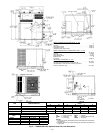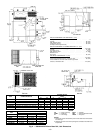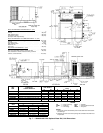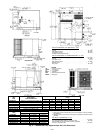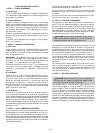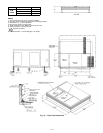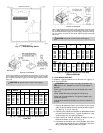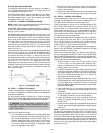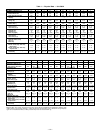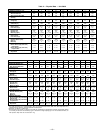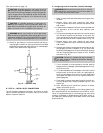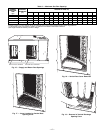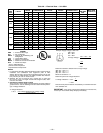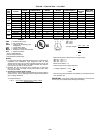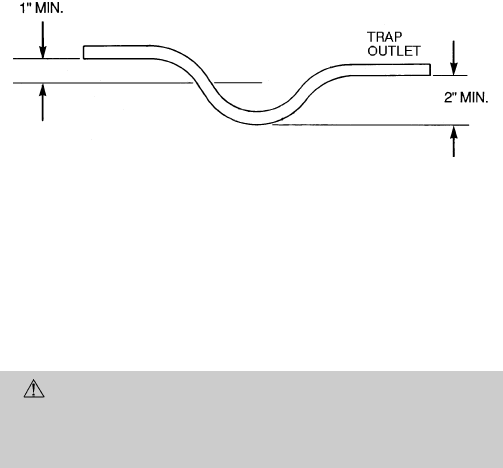
B. Units With Optional Base Rail
Lifting holes are provided in optional base rail as shown in
Fig. 13. Operating weights are shown in Tables 1 and 2. Re-
fer to rigging instructions on unit.
Protective wood support must be removed from unit before
unit is mounted to curb. Remove 4 screws that secure sup-
port above rigging holes in rails. Slide support out through
rectangular hole in rail. See Fig. 13.
VI. STEP 6 — CONNECT CONDENSATE DRAIN
NOTE: When installing condensate drain connection be sure
to comply with local codes and restrictions.
Model 588A, 589A disposes of condensate water through a
3
⁄
4
in. NPT fitting whichexits through the compressor access panel.
See Fig. 2-9 for location.
Condensate water can be drained directly onto the roof in roof-
top installations (where permitted) or onto a gravel apron in
ground-level installations. Install a field-supplied conden-
sate trap at end of condensate connection to ensure proper
drainage. Make sure that the outlet of the trap is at least
1 in. lower than the drain-pan condensate connection to pre-
vent the pan from overflowing. See Fig. 14. Prime the trap
with water. When using a gravel apron, make sure it slopes
away from the unit.
If the installation requires draining the condensate water away
from the unit, install a 2-in. trap at the condensate connec-
tion to ensure proper drainage. See Fig. 14. Make sure that
the outlet of the trap is at least 1 in. lower than the drain-
pan condensate connection to prevent the pan from overflow-
ing. Prime the trap with water. Connect a drain tube using a
minimum of
3
⁄
4
-in. PVC or
3
⁄
4
-in. copper pipe (all field-
supplied) at the outlet end of the 2-in. trap. Do not undersize
the tube. Pitch the drain tube downward at a slope of at least
one in. for every 10 ft of horizontal run. Be sure to check the
drain tube for leaks.
VII. STEP 7 — INSTALL FLUE HOOD
The flue hood assembly is shipped screwed to the control box
in the burner compartment. Remove the burner access panel
to locate the assembly.
For units being installed in California Air Quality Manage-
ment Districts which require NO
x
emissions of 40 nanograms/
joule or less, kit CRLOWNOX001A00 must be installed.
CAUTION:
The venting system is designed to en-
sure proper venting. The flue hood assembly must be
installed as indicated in this section of the unit instal-
lation instructions.
Install the flue hood as follows:
1. This installation must conform with local building codes
and with the National Fuel Gas Code (NFGC), Ameri-
can National Standards Institute (ANSI) Z223.1 (in
Canada, CAN/CGA B149.1, and B149.2) or NFPA (Na-
tional Fire Protection Association) latest revision. Refer
to Provincial and local plumbing or wastewater codes
and other applicable local codes.
2. Remove from shipping location. Place vent cap assem-
bly over flue panel. Orient screw holes in vent cap with
holes in the flue panel.
3. Secure flue hood to flue panel by inserting a single screw
on the right side, the left side, and the top of the hood.
VIII. STEP 8 — INSTALL GAS PIPING
The gas supply pipe enters the unit through the access hole
provided. The gas connection to the unit is made to the
1
⁄
2
-in.
FPT gas inlet on the manual shutoff or gas valve.
Install a gas supply line that runs to the heating section. Re-
fer to Table 3 and the NFGC for gas pipe sizing. Do not use
cast-iron pipe. It is recommended that a black iron pipe is
used. Check the local utility for recommendations concern-
ing existing lines. Size gas supply piping for 0.5 in. wg maxi-
mum pressure drop. Never use pipe smaller than the
1
⁄
2
-in.
FPT gas inlet on the unit gas valve.
For natural gas applications, the gas pressure at unit gas con-
nection must not be less than 4.0 in. wg or greater than
13 in. wg while the unit is operating. For propane applica-
tions, the gas pressure must not be less than 4.0 in. wg or
greater than 13 in. wg at the unit connection.
An
1
⁄
8
-in. NPT plugged tapping accessible for test gage con-
nection must be installed immediately upstream of the gas
supply connection to the furnace.
When installing the gas supply line, observe local codes per-
taining to gas pipe installations. Refer to the NFGC ANSI
Z223.1-1988 NFPAlatest edition (in Canada, CAN/CGAB149.1,
(2)-M86). In the absence of local building codes, adhere to the
following pertinent recommendations:
1. Avoid low spots in long runs of pipe. Grade all pipe
1
⁄
4
inch in every 15 ft to prevent traps. Grade all hori-
zontal runs downward to risers. Use risers to connect to
heating section and to meter.
2. Protect all segments of piping system against physical
and thermal damage. Support all piping with appropri-
ate straps, hangers, etc. Use a minimum of one hanger
every 6 ft. For pipe sizes larger than
1
⁄
2
in., follow rec-
ommendations of national codes.
3. Apply joint compound (pipe dope) sparingly and only to
male threads of joint when making pipe connections. Use
only pipe dope that is resistant to action of liquefied
petroleum gases as specifiedby local and/or national codes.
Never use Teflon tape.
4. Install sediment trap in riser leading to heating section
per Fig. 15. This drip leg functions as a trap for dirt and
condensate.
5. Install an accessible, external, manual main shutoff valve
in gas supply pipe within 6 ft of heating section.
6. Install ground-joint union close to heating section be-
tween unit manual shutoff and external manual main
shutoff valve.
7. Pressure-test all gas piping in accordance with local and
national plumbing and gas codes before connecting pip-
ing to unit.
NOTE: Pressure test the gas supply system after the gas sup-
ply piping is connected to the gas valve. The supply piping
must be disconnected from the gas valve during the testing
of the piping systems when test pressure is in excess of
0.5 psig. Pressure test the gas supply piping system at pres-
sures equal to or less than 0.5 psig. The unit heating section
must be isolated from the gas piping system by closing the
external main manual shutoff valve and slightly opening the
ground-joint union.
Fig. 14 — Condensate Trap
—13—



